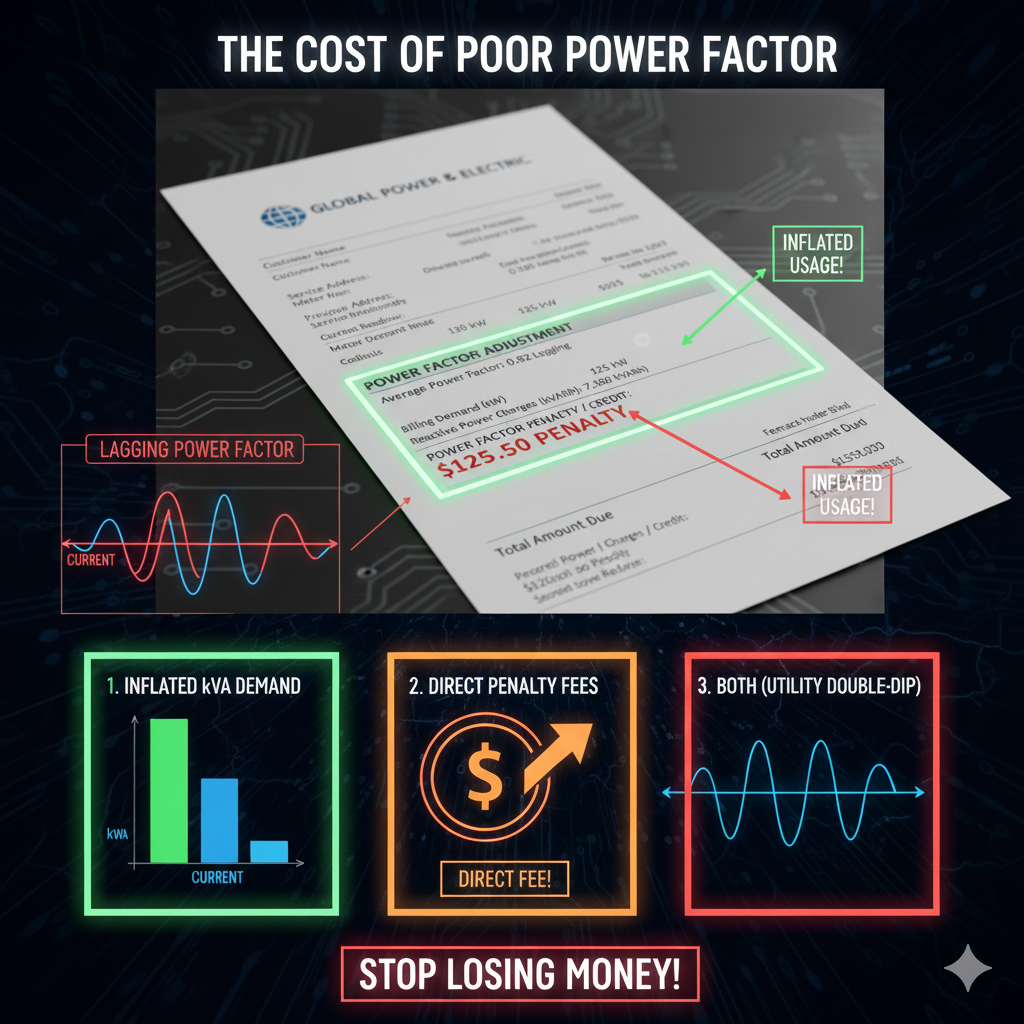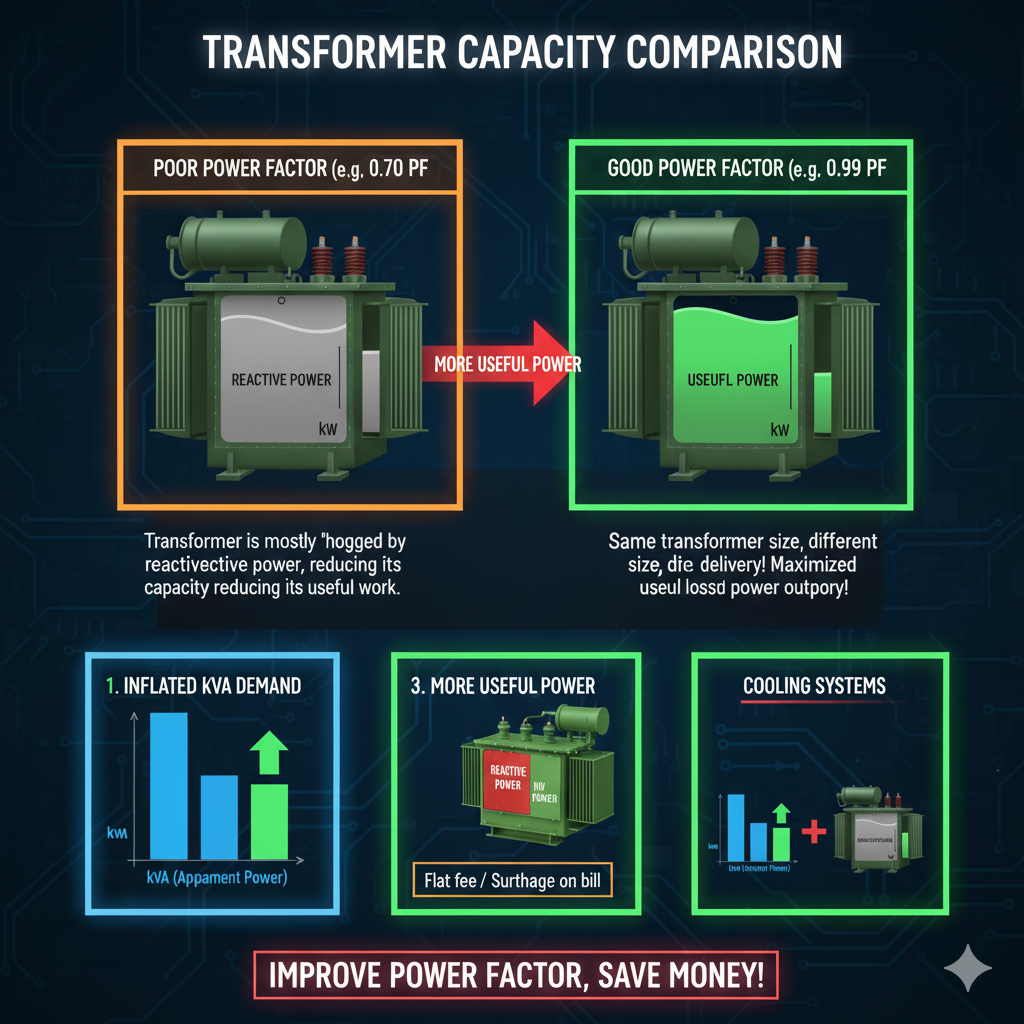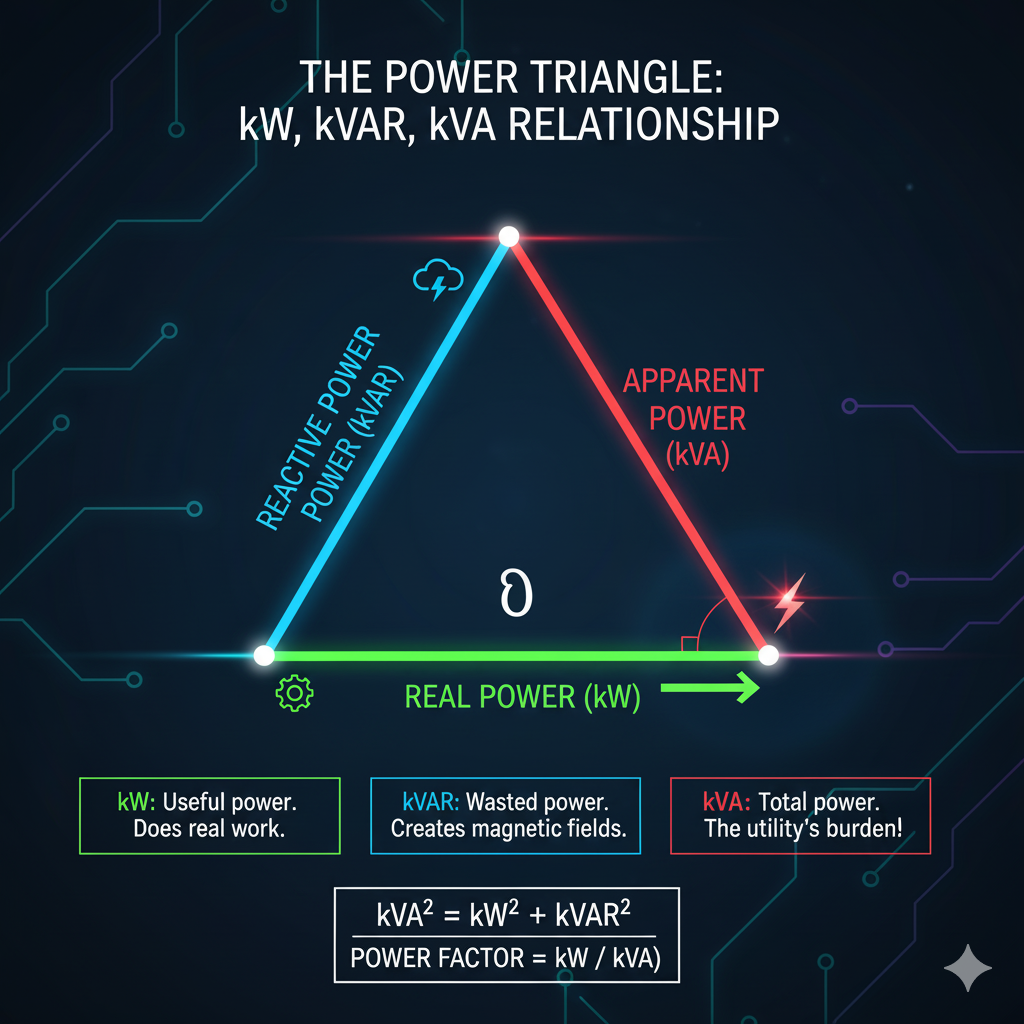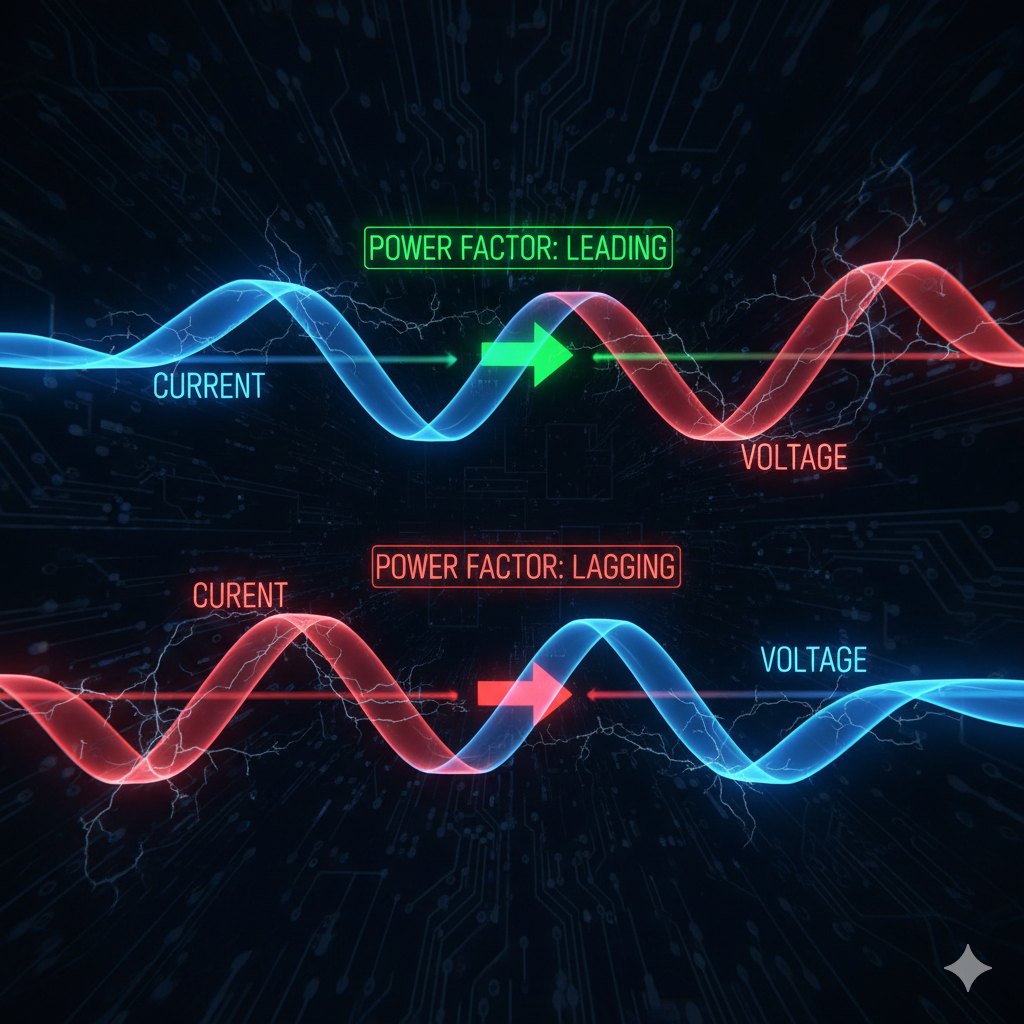Introduction: Penalize Poor Power Factor–The Line Item That Makes CFOs Cry
Let me tell you about the moment that changed everything for a manufacturing client of mine. The CFO called me, voice tight with frustration, holding their utility bill like it was a ransom note. “We’re paying an extra $4,200 this month,” he said, “for something called ‘power factor adjustment.’ What the hell is that?”
He wasn’t alone in his confusion. Across America, thousands of business owners are paying what amounts to an invisible tax on their electricity—penalties for poor power factor that show up as cryptic line items on utility bills. It’s money vanishing into thin air for something most people have never even heard of.
Here’s the thing that really gets me: these penalties are completely avoidable. They’re not like taxes or unavoidable infrastructure fees. They’re basically utility companies saying, “You’re using our electrical system inefficiently, and we’re charging you extra for the privilege.”
But why do utilities penalize poor power factor in the first place? What makes them care so much about this technical metric that they’ll slap hefty surcharges on your bill? And more importantly, what can you do about it?
Buckle up, because we’re about to pull back the curtain on one of the most overlooked aspects of commercial and industrial electricity costs—and show you exactly how to stop hemorrhaging money every month.
What is Power Factor and How Does It Affect Your Electricity Bill?
Before we dive into why utilities are so obsessed with Penalize Poor Power Factor, let’s nail down what we’re actually talking about. I promise to keep this painless.
Power factor is the ratio of useful power (the stuff that actually runs your equipment and does work) to total power (the combination of useful power and reactive power that just sloshes back and forth in your electrical system).
Think of it like this: imagine you’re paying for a moving truck to transport your office furniture. The useful power is the actual furniture filling the truck. The reactive power? That’s empty space in the truck that you’re still paying to transport. A poor power factor means you’re paying for a lot of empty space.
Power factor is expressed as a number between 0 and 1 (or 0% to 100%). Here’s what these numbers actually mean for your wallet:
- 1.0 (100%): Perfect efficiency—every bit of power you’re paying for is doing useful work
- 0.95-1.0: Excellent range—most utilities are happy here
- 0.90-0.95: Acceptable but room for improvement
- 0.85-0.90: Poor—penalties are probably kicking in
- Below 0.85: Terrible—you’re getting crushed with surcharges
How This Translates to Your Electric Bill
Your utility bill has several components, but the ones affected by power factor are:
Demand Charges: Based on your peak power usage (measured in kW or kVA) Power Factor Penalties: Direct surcharges for maintaining poor power factor Reactive Power Charges: Some utilities bill separately for reactive power (kVAR)
When your power factor is poor, you’re either:
- Paying demand charges on inflated kVA instead of actual kW usage
- Getting hit with direct power factor penalty fees
- Both (yes, some utilities double-dip)

I’ve seen facilities where power factor penalties account for 10-25% of their total electricity costs. That’s real money—money that could be invested in growth, equipment, or anything other than paying for electrical inefficiency.
Why Do Utilities Charge Penalties for Poor Power Factor?
Here’s where we get to the heart of the matter. Utilities aren’t penalizing poor power factor just to be difficult or to pad their profits (though that’s a nice side effect for them). There are legitimate, expensive reasons they care deeply about your power factor.
Reason #1: Infrastructure Stress and Capacity Limitations
When your facility has poor power factor, you’re forcing the utility to deliver more total current (amperes) than necessary to provide the useful power you actually need. This excess current—the reactive power component—flows through every wire, transformer, and piece of equipment between the power plant and your facility.
The problem? All that infrastructure has capacity limits.
Think about it like a highway system. The utility built their “roads” (transmission lines, transformers, substations) to handle a certain amount of traffic. When you have poor power factor, you’re essentially sending a convoy of empty trucks down those roads alongside the ones carrying actual cargo. You’re not using more lane space for productive purposes—you’re just congesting the system.
What this means for utilities:
- Transmission lines get loaded closer to their thermal limits
- Transformers run hotter and age faster
- Substations experience higher stress
- System capacity that could serve new customers is wasted on reactive power
And here’s the kicker: all this stressed infrastructure costs serious money to maintain, upgrade, and eventually replace.
Reason #2: Energy Losses Throughout the System
Here’s something that surprises most people: moving electrical power around creates losses. The higher the current flowing through wires and transformers, the more energy gets converted to waste heat through I²R losses (that’s current squared times resistance, for those keeping score).
When your power factor is poor, you’re drawing more current than necessary. That means:
- Higher transmission losses in the power lines between the utility and your facility
- Greater transformer losses at substations and your service entrance
- Increased heat generation in all electrical equipment
- More wasted electricity that the utility generates but you never use productively
Real numbers: A facility drawing 1,000 kW with a power factor of 0.70 requires about 1,429 amps. Improve that power factor to 0.95, and the current drops to 1,053 amps. That 376-amp reduction translates to real energy savings throughout the distribution system.
The utility has to generate and transmit all that extra electricity, absorb the losses, and somehow stay profitable. Their solution? Charge you for creating those losses.
Reason #3: Equipment Capacity and Upgrade Costs
Every component in the electrical distribution system—from generators to transformers to circuit breakers—is rated in kVA (kilovolt-amperes), not kW. That means they’re sized based on total apparent power, including reactive power.
Here’s why this matters:
A facility using 500 kW with a 0.70 power factor requires 714 kVA of capacity. That same 500 kW facility with a 0.95 power factor only needs 526 kVA. That’s a difference of 188 kVA—capacity that could serve additional customers or delay expensive infrastructure upgrades.
What costs do utilities incur because of low power factor customers?
- Oversized Transformers: They need bigger, more expensive transformers to handle the reactive power
- Upgraded Transmission Lines: Heavier conductors to carry the excess current
- Additional Generation Capacity: More generators to produce the reactive power
- Cooling Systems: Enhanced cooling for equipment running hot due to excess current
- Premature Equipment Replacement: Accelerated aging from thermal stress

I’ve worked with utilities where a single large customer’s poor power factor forced a $2 million substation upgrade that could have been delayed for years if that customer had simply corrected their power factor. Guess who pays for that upgrade eventually? Everyone in the service area through rate increases.
Reason #4: Voltage Regulation Challenges
Poor power factor doesn’t just waste capacity—it actively degrades power quality throughout the system. Low power factor causes:
- Voltage drops under load (your equipment gets less voltage than it needs)
- Voltage instability (fluctuations that stress equipment)
- Difficulty maintaining voltage within acceptable ranges (requiring additional regulation equipment)
Utilities spend millions on voltage regulation equipment—tap-changing transformers, voltage regulators, capacitor banks—to keep voltage stable. When you have poor power factor, you’re making their job harder and more expensive.
Reason #5: Grid Reliability and Stability
Modern power grids are complex, interconnected systems that require careful balancing of real and reactive power. Poor power factor from large customers can:
- Contribute to voltage collapse scenarios during high-demand periods
- Create reactive power deficits that stress the entire regional grid
- Interfere with protective relaying and system stability
- Complicate grid operators’ efforts to maintain reliable service
In extreme cases, poor power factor can contribute to brownouts or blackouts—events that cost utilities millions in lost revenue, emergency response, and regulatory penalties.
At What Power Factor Level Do Utilities Start Imposing Penalize Poor Power Factor?
This is the million-dollar question (sometimes literally). The answer varies significantly depending on your utility, your region, and your customer class, but there are common patterns.
Typical Power Factor Penalty Thresholds
Most Common Threshold: 0.95 The majority of utilities in the United States consider 0.95 the minimum acceptable power factor. Stay above this, and you’re in the clear. Drop below it, and penalties start accumulating.
Conservative Utilities: 0.90 Some utilities are more lenient, only penalizing power factors below 0.90. This is more common in regions with less stressed infrastructure.
Aggressive Utilities: 0.98 A few utilities, particularly in densely populated or constrained grid areas, expect power factors of 0.98 or better. These are rare but do exist, especially in specific industrial rate classes.
How Penalize Poor Power Factor Scale
Utilities don’t just flip a switch when you cross the threshold. Most use sliding-scale penalties that get progressively worse as your power factor drops:
| Power Factor Range | Typical Penalty |
| 0.95 – 1.00 | No penalty |
| 0.90 – 0.95 | 1-3% surcharge |
| 0.85 – 0.90 | 3-8% surcharge |
| 0.80 – 0.85 | 8-15% surcharge |
| Below 0.80 | 15-25%+ surcharge |
Real-world example from a Midwestern utility:
- Power factor of 0.92: 2% demand charge increase
- Power factor of 0.85: 5% demand charge increase
- Power factor of 0.75: 12% demand charge increase plus reactive power charges
How to Find Your Utility’s Threshold
Your utility’s power factor penalty threshold and calculation method should be published in their rate tariffs. Here’s how to find it:
- Check Your Bill: Look for sections labeled “Power Factor Adjustment,” “Reactive Power Charges,” or “Demand Factor”
- Review Rate Schedules: Available on your utility’s website, usually under “Rates” or “Tariffs”
- Call Customer Service: Ask specifically about power factor requirements for your rate class
- Consult Your Electric Meter: Many modern meters display power factor—compare to your bill
How is penalized poor Power Factor Calculated on Utility Bills?
Understanding how utilities calculate penalties is crucial because it shows you exactly where your money is going and how much you could save through correction.
Method #1: Demand Charge Adjustment (Most Common)
This is the sneaky one that many businesses don’t even realize is happening. Instead of billing based on your actual power consumption (kW), the utility bills based on apparent power (kVA).
The formula:
Billing Demand (kVA) = Actual Demand (kW) / Power Factor
Example:
- Your actual demand: 500 kW
- Your power factor: 0.75
- Billing demand: 500 / 0.75 = 667 kVA
- Demand charge rate: $15/kVA
- You pay: 667 × $15 = $10,005
- You should pay (at PF 0.95): 526 × $15 = $7,890
- Penalty: $2,115/month = $25,380/year
That’s real money for doing absolutely nothing different—just inefficiently.
Method #2: Direct Power Factor Penalty Multiplier
Some utilities apply a direct penalty percentage when power factor falls below threshold.
The formula:
Penalty % = (Target PF – Actual PF) / (Target PF – Penalty Threshold) × Max Penalty %
Example from an actual utility tariff:
- Target power factor: 0.95
- Your power factor: 0.82
- Penalty threshold: 0.95
- Maximum penalty: 10%
- Calculation: (0.95 – 0.82) / 0.95 × 10% = 1.37% penalty
- Monthly electric bill: $45,000
- Penalty: $45,000 × 1.37% = $616.50/month
Method #3: Reactive Power Charges (kVAR Billing)
Some utilities bill separately for reactive power consumption.
The measurement:
- Real Power: kW (what you use productively)
- Reactive Power: kVAR (the wasted component)
- Apparent Power: kVA (the total)
Relationship:
kVA² = kW² + kVAR²
Example billing:
- Real power: 400 kW @ $0.08/kWh
- Reactive power: 300 kVAR @ $0.02/kVARh
- Monthly real power cost: $23,040
- Monthly reactive power cost: $4,320
- Total impact: 18.75% increase due to reactive power

Method #4: Time-of-Use Power Factor Penalties
More sophisticated utilities apply different penalty structures based on when poor power factor occurs:
Peak hours (typically 12 PM – 8 PM weekdays):
- Stricter penalties
- Higher multipliers
- May require 0.98 instead of 0.95
Off-peak hours:
- More lenient penalties
- May not penalize at all below certain thresholds
Why? Peak times are when grid stress is highest, so utilities care most about power factor then.
Reading Power Factor Charges on Your Bill
Common line items to look for:
- “Power Factor Adjustment”
- “Reactive Demand Charge”
- “kVAR Charge”
- “Demand Factor Penalty”
- “Power Factor Surcharge”
- “Reactive Power”
Red flags that you’re being penalized:
- Demand charges listed in kVA instead of kW
- Separate line items for reactive power
- Adjustment factors greater than 1.0 applied to demand charges
- Footnotes referencing power factor correction

Calculating Your Potential Savings
Here’s a simple way to estimate how much you could save by correcting power factor:
Step 1: Identify your current monthly power factor penalty (check bill) Step 2: Multiply by 12 for annual cost Step 3: Estimate correction cost (typically $50-150 per kVAR of correction needed) Step 4: Calculate payback period (correction cost / annual savings)
Most power factor correction projects have payback periods of 1-3 years, making them excellent investments with ongoing returns.
What Types of Businesses Are Most Affected by Poor Power Factor Penalties?
Not all businesses are created equal when it comes to power factor problems. Some industries are penalty magnets, while others barely notice the issue. Here’s the breakdown of who gets hit hardest and why.
Industries Most Impacted by Penalized Poor Power Factor
Manufacturing Plants: The #1 Target
If you run a manufacturing operation, you’re almost certainly dealing with power factor penalties. Why? Motors. Lots and lots of motors.
Common culprits:
- Assembly line motors
- Conveyor systems
- Pump stations
- Air compressors (running continuously)
- Material handling equipment
- Industrial fans and blowers
Typical power factors without correction: 0.65-0.80
Average monthly penalties: $2,000-$10,000+ depending on facility size
I once worked with a metal fabrication shop pulling 750 kW with a power factor of 0.68. They were paying $4,800/month in penalties—$57,600 annually—just for running their equipment inefficiently. After installing an automatic capacitor bank system for $42,000, they eliminated the penalties completely. Payback in nine months.
Machine Shops and Metalworking
CNC machines, lathes, mills, grinders, welding equipment—all heavily inductive. Plus, many machines run at partial load much of the time, which makes power factor even worse.
Typical power factors: 0.70-0.85
Cold Storage and Food Processing
Massive refrigeration compressors running 24/7. These are some of the most power-factor-destructive loads you can have.
Additional issues:
- Multiple large motors cycling on and off
- Significant lighting loads (often older fluorescent)
- Conveyors and packaging equipment
Typical power factors: 0.75-0.88
Automotive Repair and Body Shops
Smaller facilities but packed with inductive loads:
- Welders (extremely inductive)
- Air compressors
- Lifts and hoists
- Paint booth fans
- Diagnostic equipment
Even a small 3-bay shop can see $500-1,000/month in penalties.
Warehouses and Distribution Centers
The growth of e-commerce has created massive warehousing facilities with:
- Conveyor systems running constantly
- Material handling equipment
- HVAC systems for climate control
- Lighting (though LED upgrades have helped)
Typical power factors: 0.80-0.90
Water and Wastewater Treatment
Municipal and industrial water treatment facilities are penalty goldmines for utilities:
- Enormous pump stations
- Aeration blowers
- Mixers and agitators
- Chemical feed pumps
These facilities often run 24/7 with steady loads, making them ideal candidates for fixed capacitor correction.
Typical power factors without correction: 0.70-0.82
Commercial Laundries
High-capacity washers and dryers, pressing equipment, conveyors—all motors, all the time.
Commercial Printing
Printing presses, particularly older models, are motor-heavy operations with poor power factor characteristics.
Woodworking and Furniture Manufacturing
Saws, planers, sanders, routers, dust collection systems—an inductive load paradise.
Industries Moderately Affected
Office Buildings (Older)
Modern offices with LED lighting and energy-efficient HVAC do okay. But older buildings with:
- Magnetic ballast fluorescent lighting
- Aging HVAC systems
- Multiple elevators
- Server rooms with older UPS systems
…can see meaningful Penalize Poor Power Factor.
Typical power factors: 0.85-0.92
Retail Stores (Large Format)
Big-box retailers with extensive HVAC, lighting, and refrigeration can experience Penalize Poor Power Factor, though usually less severe than industrial facilities.
Restaurants (Full Service)
Commercial kitchens have:
- Refrigeration and freezers
- Hood fans
- Dishwashers
- HVAC
Smaller facilities might not notice, but chain restaurants should pay attention to cumulative penalties across locations.
Industries Least Affected
Data Centers: Modern IT equipment actually has decent power factor (0.90-0.95) thanks to active power factor correction in power supplies. However, older UPS systems and cooling equipment can still create issues.
Healthcare Facilities: Hospitals have diverse loads that often naturally balance somewhat, though specific areas (radiology, mechanical rooms) can have poor power factor.
Residential: Homeowners almost never face direct power factor penalties, though they indirectly pay through rate structures that cover industrial penalties.
Can Power Factor Correction Help Reduce or Eliminate Penalize Poor Power Factor?
The short answer: absolutely, and usually dramatically. Power factor correction is one of the highest-ROI investments you can make in your facility’s electrical system.
How Power Factor Correction Works
The basic principle is simple: you’re offsetting inductive reactive power (from motors and transformers) with capacitive reactive power (from capacitors). It’s like adding a counterweight to balance a scale.
The goal: Bring your power factor up to 0.95 or higher to eliminate or minimize penalties.
The methods:
- Fixed Capacitor Banks: Always-on capacitors providing constant correction
- Automatic Capacitor Banks: Intelligent systems that switch capacitor stages in and out based on load
- Synchronous Condensers: Rotating machines that can provide variable reactive power
- Active Filters: Advanced electronic systems handling power factor and harmonics simultaneously
Real-World Correction Success Stories
Plastics Manufacturer
- Before: 850 kW demand, 0.72 power factor
- Monthly penalty: $3,600
- Solution: $48,000 automatic capacitor bank system
- After: 0.97 power factor
- New penalty: $0
- Annual savings: $43,200
- Payback: 13 months
Distribution Warehouse
- Before: 400 kW demand, 0.81 power factor
- Monthly penalty: $1,850
- Solution: $28,000 power factor correction system
- After: 0.96 power factor
- Annual savings: $22,200
- Payback: 15 months
- Bonus: Reduced equipment temperatures, fewer maintenance issues
Machine Shop
- Before: 250 kW demand, 0.68 power factor (terrible!)
- Monthly penalty: $2,400
- Solution: $35,000 advanced system with harmonic filtering
- After: 0.95 power factor
- Annual savings: $28,800
- Payback: 14.5 months
Beyond Penalize Poor Power Factor Elimination: Additional Benefits
Here’s what makes power factor correction even more attractive—the savings extend beyond just eliminating penalties:
1. Increased System Capacity Correcting power factor frees up capacity in your transformers, cables, and switchgear. That 15-30% capacity increase means you can add equipment without upgrading infrastructure.
Value: Deferred capital costs of $50,000-$500,000+ depending on facility size
2. Reduced Voltage Drop Better power factor means lower current, which means less voltage drop across your distribution system. Your equipment gets the voltage it’s designed for.
Benefits:
- Better motor performance
- Extended equipment life
- Fewer nuisance trips
- Improved lighting quality
3. Lower Energy Losses Reduced current throughout your system means lower I²R losses in cables, transformers, and all electrical equipment.
Typical savings: 1-3% reduction in total energy costs
4. Cooler Running Equipment Lower currents mean less heat generation in every component.
Benefits:
- Extended transformer life (heat is the #1 killer)
- Reduced cooling costs
- Lower maintenance requirements
- Fewer emergency repairs
5. Improved Motor Performance Motors run cooler and more efficiently with proper voltage and reduced system stress.
6. Environmental Benefits Less wasted electricity means reduced emissions from power generation—a meaningful consideration for companies with sustainability goals.
Correction System Sizing and Selection
Key considerations when choosing correction equipment:
1. Calculate Required Correction
Required kVAR = kW × (tan(arccos(PF current)) – tan(arccos(PF target)))
Or use online calculators (multiple free tools available).
2. Choose Fixed vs. Automatic
Fixed systems: Best for steady, predictable loads
- Lower cost
- Simple installation
- Minimal maintenance
Automatic systems: Essential for variable loads
- Higher initial cost
- Adapts to changing conditions
- Prevents over-correction
- Better long-term performance
3. Consider Harmonics
If you have variable frequency drives, computers, LED lighting, or other electronic loads, you need detuned (harmonic-filtering) capacitors to prevent resonance problems.
Warning: Standard capacitors + harmonics = potential disaster (blown fuses, damaged equipment, worse power quality)
Top Power Factor Correction Products
For Industrial Applications:
ZDDQ Low Voltage Power Factor Corrector Real-time adaptive control, perfect for facilities with varying loads. Excellent reliability.
ABB Power Factor Correction Panels Complete integrated solution, easy installation, robust construction for harsh environments.
Schneider Electric PowerLogic PFC Capacitor Banks Industry-standard quality with excellent monitoring and control capabilities.
For Commercial Buildings:
Eaton Power Factor Correction Capacitors Reliable, cost-effective solution for office buildings and retail.
Ortea Next LV Power Factor Correction System Great value for medium-sized facilities, maintains power factor within utility limits automatically.
For Facilities with Harmonic Issues:
Frako Power Factor Correction with Harmonic Filters Combined solution addressing both power factor and harmonic distortion.
Advanced Capacitor Banks with Harmonic Blocking Reactors Prevents resonance while providing power factor correction.
Installation and Commissioning
Professional installation is crucial. I’ve seen DIY power factor correction attempts that:
- Created resonance problems costing $50,000 to fix
- Damaged equipment through over-correction
- Failed to achieve expected savings due to improper sizing
What to expect:
- Professional assessment and sizing: $2,000-5,000
- Equipment cost: $50-150 per kVAR
- Installation labor: $5,000-15,000 depending on complexity
- Commissioning and verification: $1,000-3,000
Total typical project: $30,000-80,000 for medium industrial facility
Payback: 12-36 months through penalty elimination alone
How to Find Out If Your Business is Being Penalize Poor Power Factor
If you’ve read this far and are thinking, “Wait, am I paying power factor penalties and didn’t even know it?”—you’re not alone. Many businesses have no idea they’re being penalized. Here’s how to find out.
Pull out your most recent electric bill (or better yet, 12 months of bills) and look for these tell-tale signs:
Step 1: Examine Your Utility Bill Carefully
Direct penalty indicators:
- Any line item with “power factor” in the name
- “Reactive demand” charges
- “kVAR” charges
- “Demand factor” adjustments
- Multipliers greater than 1.0 applied to demand charges
Indirect indicators:
- Demand charges based on kVA instead of kW
- Footnotes mentioning power factor requirements
- Adjustments or riders with cryptic codes (check rate tariff for definitions)
Pro tip: Many utilities hide power factor penalties in the demand charge calculation rather than showing them as separate line items. You might be paying without realizing it.
Step 2: Check Your Facility’s Power Factor
If you have modern metering: Many digital meters display power factor directly. Check your main meter or any sub-meters you have installed.
Where to look:
- Digital meter display (may need to cycle through screens)
- Building management system readouts
- Energy monitoring software
- SCADA systems (industrial facilities)
If you don’t have power factor monitoring: Time to get it. Options include:
- Portable power quality analyzer (rent or buy): $500-5,000
- Clamp meter with power factor function: $200-800
- Hire an electrical contractor for assessment: $500-2,000
- Install permanent monitoring: $2,000-10,000
What you’re looking for:
- Power factor values below 0.95
- Highly variable power factor throughout the day
- Leading power factor (indicates over-correction)
Step 3: Review Your Rate Schedule
Every utility publishes their rate schedules (tariffs) which spell out power factor requirements and penalty structures.
Where to find it:
- Utility company website (usually under “Rates” or “Tariffs”)
- Your utility account manager
- State public utility commission website
- The fine print on your bill (often references specific tariff schedules)
What to look for:
- Minimum power factor requirements for your rate class
- How penalties are calculated
- Whether penalties vary by time of day or season
- Any incentives or rebates for power factor improvement
Step 4: Calculate Your Penalize Poor Power Factor Exposure
Once you know your power factor and your utility’s penalty structure, you can calculate what you’re actually paying.
Simple estimation method:
- Find your monthly demand charge ($/month)
- Note your current power factor
- Calculate what demand charge would be at 0.95 PF
- The difference is your approximate monthly penalty
Example:
- Current monthly demand charge: $8,500
- Current power factor: 0.78
- Demand charge at 0.95 PF would be: ~$6,950
- Estimated monthly penalty: $1,550
- Annual exposure: $18,600
Step 5: Request a Power Quality Audit
For facilities with significant electrical loads, a professional power quality audit is worthwhile. A qualified electrical engineer or power quality specialist will:
- Measure power factor throughout your facility
- Identify specific equipment causing problems
- Calculate exact penalty costs
- Recommend correction solutions
- Provide ROI analysis
Cost: $2,000-8,000 depending on facility size
What you get: Detailed report with actionable recommendations and financial projections
Red Flags That You’re Definitely Being Penalize Poor Power Factor
utility bill shows:
- Demand charges significantly higher than expected for your kW usage
- Month-to-month variation in demand charges that doesn’t match production/usage patterns
- References to “reactive power” or “kVAR”
equipment exhibits:
- Transformers running hot
- Frequent breaker trips without obvious overloads
- Voltage fluctuations when large equipment starts
- High amp readings relative to power consumption
operations include:
- Many electric motors (especially older or lightly loaded)
- Welding equipment
- Induction heating
- Large HVAC systems
- Older fluorescent lighting
If you check three or more of these boxes, you’re almost certainly paying power factor penalties.
Do Residential Consumers Face Penalize Poor Power Factor?
Here’s a question I get all the time from homeowners: “Should I worry about power factor at home?”
The short answer: Not directly, but you’re still paying for it indirectly.
Why Residential Customers Usually Don’t See Direct Penalize Poor Power Factor
Reason #1: Rate Structure Residential rate schedules typically don’t include power factor provisions. You’re billed based on kilowatt-hours (kWh) of energy consumed, not demand (kW or kVA), and there’s no adjustment for power factor.
Reason #2: Scale Individual homes, even with poor power factor, don’t stress the utility grid the way industrial facilities do. The impact is too small to justify the administrative cost of monitoring and billing for power factor.
Reason #3: Measurement Complexity Most residential meters don’t measure or record power factor. Upgrading meters to do so would cost more than utilities could recover through residential penalties.
Reason #4: Political Considerations Charging homeowners penalties for a technical concept most don’t understand would be a public relations nightmare for utilities.
But You’re Still Paying (Indirectly)
Here’s the thing: utilities recover all their costs—including losses from poor industrial power factor—through rate structures. When industrial customers don’t correct their power factor:
- The utility incurs higher infrastructure and operational costs
- These costs get rolled into base rates
- Everyone pays higher rates, including residential customers
It’s like insurance: everyone pays a bit more to cover the costs created by a subset of customers.
When Residential Power Factor Might Matter
Scenario #1: Home Machine Shop or Workshop If you’re running significant motor-driven equipment at home—table saws, lathes, air compressors, welders—your power factor might be poor. While you won’t see penalties, you might benefit from correction through:
- Reduced voltage drop (better equipment performance)
- Lower current draw (possibly allowing more equipment on


